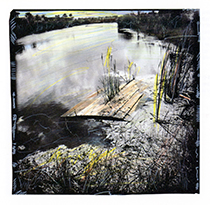Wayne Sides, 1975 New College alumnus in visual and performing arts, is in the process of scanning his  entire photographic oeuvre of more than four decades. As part of this project, he is displaying more and more of those pieces on his new website. Part Two of our feature on artists digitizing their work outlines how he has organized the project, including the workflow, storage and the website. Read Part One here.
entire photographic oeuvre of more than four decades. As part of this project, he is displaying more and more of those pieces on his new website. Part Two of our feature on artists digitizing their work outlines how he has organized the project, including the workflow, storage and the website. Read Part One here.
Sides said that he set certain general parameters according to archiving standards and adapted others for what works best for his purposes. From the beginning, organizing is key. Sides stores his film negatives in pages in binders and boxes. Prints are mostly in print storage boxes. “During the digitization process, negatives were cleaned and then stored in number-coded negative storage pages and correspondingly cataloged in a document file database,” Sides explained, “The entire negative page collection was also scanned, to generate a low-resolution digital reference – a contact sheet – for each. For images that are chosen from the negative collection, each film frame is cleaned, prepared, then scanned and the resulting high-resolution file is then stored on hard drives.” The high-resolution versions of the digitized images are stored on multiple professional external hard drives on- and off-site. Regarding “cloud” storage, Sides said, “There have been interesting developments in the realm of cloud storage options, but for now I use cloud-based options only for reference needs with low-resolution images or collaborative works where an author or publisher also needs to have access.”

Sides works with a professional photographer, a former student who has expertise in scanning and setting up what archivists term the workflow process in large digitizing projects. He also has a broad understanding of the traditional darkroom process and methods, with experience with the various film stocks and chemical processes that were used to create the negatives. For this type of scanning project, experience in film photography helps in understanding what the final digital image should look like. Sides explained, “The different film emulsions, grain structures, and chemistry which I have experimented with over the years for different projects or looks, make it difficult to adjust to all the variables to get consistent and matching results of how the digital image should look as if it is in a traditional darkroom environment. I very much treat the current archiving approach as a “digitization” with the traditional darkroom approach in mind.”
The high-resolution images contain the relevant standard information parameters for metadata, or embedded file information. For the time being, Sides has left off titles and other information from the website images, preferring, he said, “to let the viewer’s imagination think about the image rather than speak of specific places and such. I do plan to add some background contextual information and titles in the future.”
Sides estimates that more than 2000 images of his photographic work have been digitized and only about twenty percent remains to scan. Only a very small representation of the complete body is on the website now. “Of course the intention was never to put all the images online, as some will be used in other projects, shows and publications. The website will be just a sampling of the work from the archive, which will exhibit a variety of works in the future.” His idea is that the website will evolve over time, explaining, “I will probably shift over to a more fully responsive website design as things progress, and also adapt to new and evolving portable technologies, to add more functionality over time.”

As with any life-encompassing project, there can be a slow incubation process before it’s actually begun. Sides said, “It is a lot to organize and perhaps I should have started this a couple years back before I did, however it is really great to start having access to the images and sharing the work through digital means as well.”
Wayne Sides’ website: http://www.waynesides.com/.
Read Part One of this article: https://art.ua.edu/loupe/wayne-sides-collecting-four-decades-of-photos/
IMAGE CREDITS:
top right: Wayne Sides, courtesy the artist.
middle right: Wayne Sides, photograph from Litany for a Vanishing Landscape, 1990.
two “galleries”: screenshots from the website: http://www.waynesides.com/work/gallery-vii/
featured image: Wayne Sides, photograph from Sideshow, page 24, 1979. Location: Decatur, Ala., 1978.
[s16]
If YOU have begun a digitizing project of your own or have just begun thinking about it, we’d like to hear from you. Please write or call Rachel Dobson, even if it’s just to let me know you’re interested and are going to think on it. We believe this is a significant and developing story about how artists live in the 21st century and we hope this will be a semi-regular feature of The Loupe.